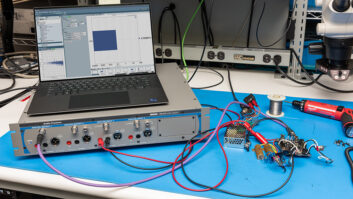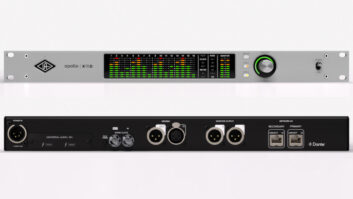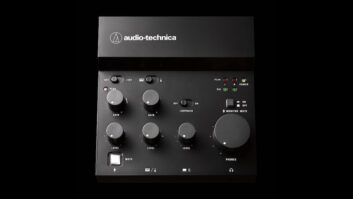
The Antelope Audio Orion 32 offers USB, MADI, ADAT and S/PDIF I/O.
I’ve been getting many clients asking if I can come to them and create a great-sounding recording environment in the comforts of their project studio, live show and other places. While I do have a stable and reliable mobile rig, I’m not motivated to tear apart my studio system, pack it up and take it on the road.
For this purpose, I’ve always wanted a great-sounding multichannel rig with a small footprint. Wouldn’t it be great to have multiple channels of I/O that are easy to set up and tear down, with no compromise in audio quality? The Antelope Orion 32 just may be the bridge to this endeavor. Yes, the future is here, and it sounds really, really good.
Big Things, Small Packages
Antelope has been known in the pro audio community as a company that creates uncompromising master-quality clocks and converters for the high-end user. When I first heard about the Orion 32 and its price, I was a bit skeptical about how well the unit would compete with others in its range, units that typically offered half or even less than half the I/O. The Orion 32 is a sleek, cleanly designed interface that provides 32 channels of high-quality low-latency AD/DA (the custom-built USB chip provides USB 2 Hi-Speed; streaming data up to 480 Mbits/192 kHz, 32 channels I/O, Type B). Antelope’s well-known 64-bit AFC (Acoustically Focused Clocking) technology contains four word-clock outputs and one word-clock input that rely on Antelope’s proprietary Oven Controlled Oscillator.
The back panel also provides eight D-sub connectors, one fiber-optic MADI, two fiber ADAT, and one S/PDIF and USB connections. The USB slot allows for easy interfacing with a DAW on a Windows or Mac laptop, iPad or standalone computer. The 32 channels at 96k can be achieved through its MADI connection. Orion also includes ADAT connectivity, offering 16 channels of I/O with analog signal passed through the eight D-sub connectors on the back of the unit. It sips power at 20 watts via an IEC connection, keeping the unit at lower heat levels, and runs quietly for those who are working in the same room.
Flexibility Is a Click Away
The front panel provides an LED interface with an easy view of your sample rate but the metering is very small. It’s visually pleasing, but difficult to read the actual levels on 32 channels of metering when in use. Antelope has provided a versatile desktop software application for Windows and OS X (I had OS X format) that allows the user to create flexible routing of the I/O inside the unit, click-and-drag options and the ability to save setups for access off of five front-panel buttons.
The metering and buttons are mirrored on the control panel but are much more reliable in the application. I found myself keeping it open when I was using the unit with my tower and had another screen available. On my laptop I had it running in the background behind Pro Tools and referred to it when getting levels to check against my calibration settings.
There was a bit of a learning curve with the software, but once I spent some time with it, I was able to move efficiently within the application to create a few presets I could rely on for different sessions. Some presets used the internal clock, others clocking off the dedicated master clock in my studio. The first version of the software I downloaded worked well with my laptop, but it didn’t play quite as well with the desktop, requiring at least OS X 10.8. (I found an update on the site that allowed me to correct issues and was quickly running soon after.) I accessed a few helpful videos on the Antelope website that helped me understand the capabilities of the routing on the control panel and how powerful the application can be in helping set up the I/O.
Discovering Orion
For the first test session, I set the clock to the Orion 32’s internal clock to 44.1k via the desktop software and USB. Then I checked the calibration with the test tone oscillators provided in the software to match the settings of the converters in my studio. I first recorded a guitar/vocal through a pair of Rupert Neve Portico 511 preamps, which I am very familiar with, as I am with my UA 2192 and Lynx Aurora 16.
The converters sounded very clean, the upper and lower midrange of the guitar was well-proportioned, and the presence and top end of the vocal was detailed. I then plugged in a keyboard to add a bass part and a drum loop to fill out the track. The flexible routing of the I/O from the desktop application made it easy to keep my routing in place without having to change any cabling on the Lunchbox that housed the preamps. The bottom end was full, tight and punchy, even in the sub-octave range of the keyboard bass below the kick drum I had chosen. Now that I had a basic track going, I wanted to compare it to my converters and repeat another pass I had recorded through the Orion 32 on the laptop.
I repeated the same tracks once with the 2192, and then again through the Lynx converters. Keep in mind that the two channels on the 2192 cost around $2,400 when I purchased it, and the Lynx is a 16-channel unit that comes in around $2,695. The Orion and the Lynx tracks were almost indistinguishable upon several listens—too close to notice any major differences even when even soloing out the individual tracks. The UA tracks were decidedly different, the bottom and top end being more detailed, more precise on the top end and the bottom end had more punch and definition.
I then brought in a few reference stereo tracks of mixes I had done in the past and listened on all three converters that I typically will use when getting used to working in a different room. Again, the results were very similar between the Orion 32 and the Lynx, with the UA providing a little clearer picture overall. I added a couple of hardware inserts via the patch bay with all three tests and was pleased to hear that the Orion 32 works very well with external processing applications. I could easily see mastering rooms using the Orion 32’s stable clock and the converters for their projects, while using the flexible routing for using outboard gear. The low latency levels (ranging from 1ms to 6ms based on the DAW platform) of the I/O competed equally well with my other units.
iPad Recording
Orion is fully iOS compatible, so I next tried connecting the Orion 32 with an iPad via the camera adapter. I opened Auria by Wave Machine Labs to record a multitracked drum set to some existing tracks in my tracking room. I wanted to see how the unit would perform being in the same space where I would be recording. The I/O saw the DAW right away and ran the preamps right into the unit via the one D-sub connector on the back of the unit off to the D-sub of an API Lunchbox. Talk about a portable rig! The drummer remarked that he could not believe we were recording into an iPad, and that it sounded like a record. I got it back to my studio, imported the WAV files and was really impressed by the sonics that I had captured.
Orion had been performing really well with my laptop in both the studio and remotely, so I then wanted to test it with my Mac Pro tower and HD rig. I plugged the USB cable (I don’t have MADI compatibility with this setup) into the back of the computer and powered up the unit. All of my I/O preferences and computer outputs then changed to reflect the Orion 32, which was not what I anticipated. I spent some time chasing the defaults, and finally found a workaround in downloading the latest driver from the Antelope website. The problem is that Orion reset the audio settings, Digi core audio preferences and caches. Once I learned this, I was able to reset my usual computer outputs to my preferred settings and I was back to normal.
I set out to multitrack local Nashville rock band The Blackfoot Gypsies with different sample rates, recording all tracks at the same time. The 44.1 and 48k tracks sounded stellar—very close to what I was used to hearing in my room. Once I moved up to 88.2 and 96k, the tracks sounded a bit cloudier on the top end, and there wasn’t as much detail throughout the whole frequency range. The next day I tested the signal-to-noise ratio at different sample rates and found that the noise increased slightly when the sample rate increased via the USB connection. Since I typically record most of my projects at 44.1, this wasn’t a major issue for me. The internal clock performed extremely well on both the laptop and desktop—so much to the point that when I went to apply my own dedicated clock back to a session on the desktop, I thought I had already done so after listening for some time. The differences at the lower sample rates were very similar, and only when I got above 48k did the dedicated clock start to show its difference.
Proof Positive
After testing Orion 32 in a variety of situations and applications, I walked away with a different perspective. I thought that having 32 channels and dedicated clock in a unit of this size might sacrifice quality of the audio conversion. I expected the clock to be great, as that is what we all have known Antelope for in the past. The conversion did not disappoint; in fact, it was highly competitive with units that would cost twice as much to have as many channels.
The flexibility of the routing, which took a little time to master, provided easy solutions for most situations. Adding the iOS compatibility, users can create one of the best-sounding and most portable recording packages for multitrack recording I have come across. The Antelope Orion 32 has raised the bar for this level of integrating audio quality and cutting-edge technology, and I can only hope to see others taking advantage of what the Orion 32 has to offer.
Chris Grainger is a producer/mixer/engineer and owner of Undertow Studio in Nashville. www.itsgrainger.com; @itsgrainger.
Product Summary
COMPANY: Antelope Audio
PRODUCT: Orion 32
WEBSITE:antelopeaudio.com
PRICE: $2,995
PROS: 32 channels of affordable high-end converters in a single-space unit, super-stable clock, low-latency inserts, portable and easy to interface with a laptop, iPad or desktop.
CONS: LED meters hard to read, sample rates above 48k weren’t as clean via USB, initial connection to tower cleared my default I/O settings.







